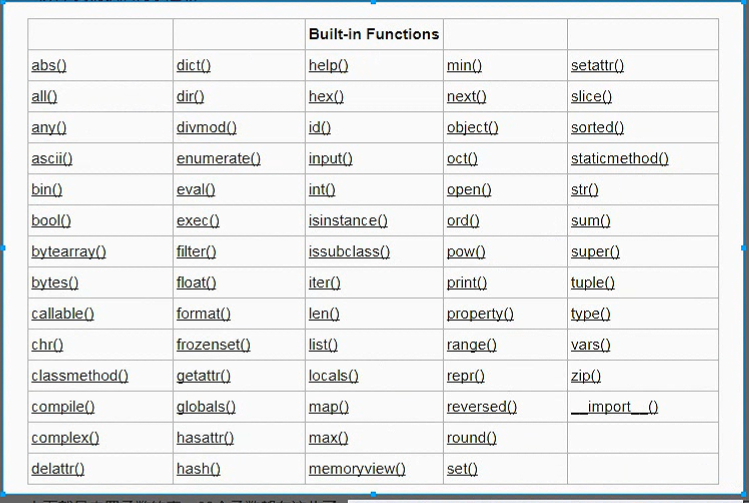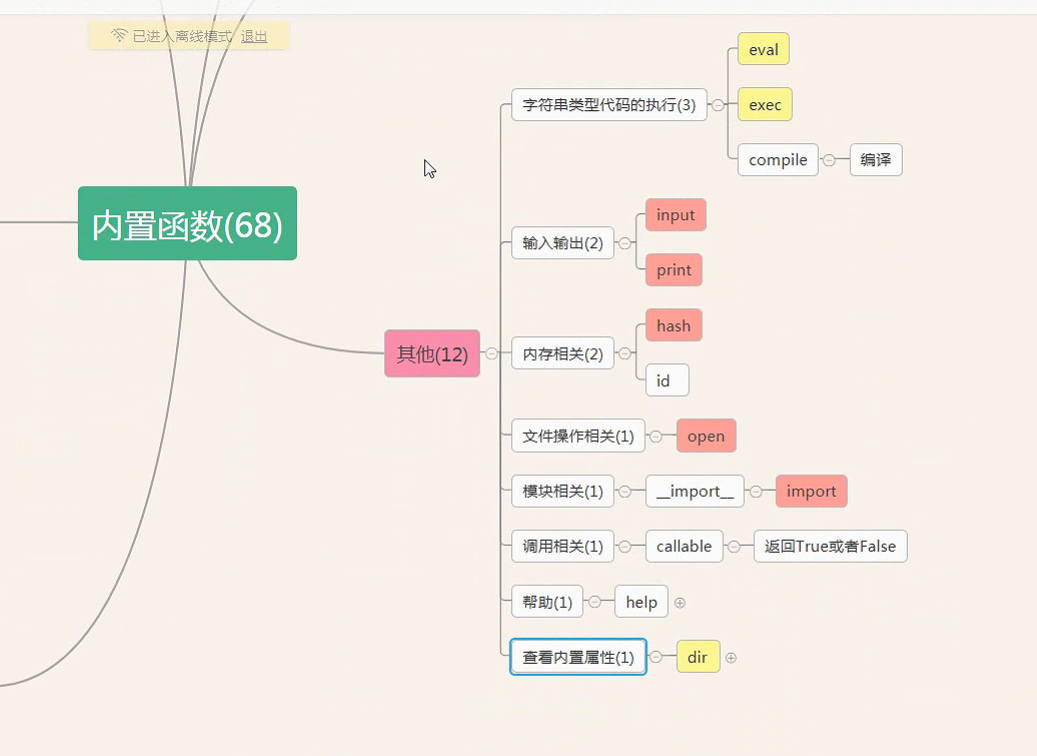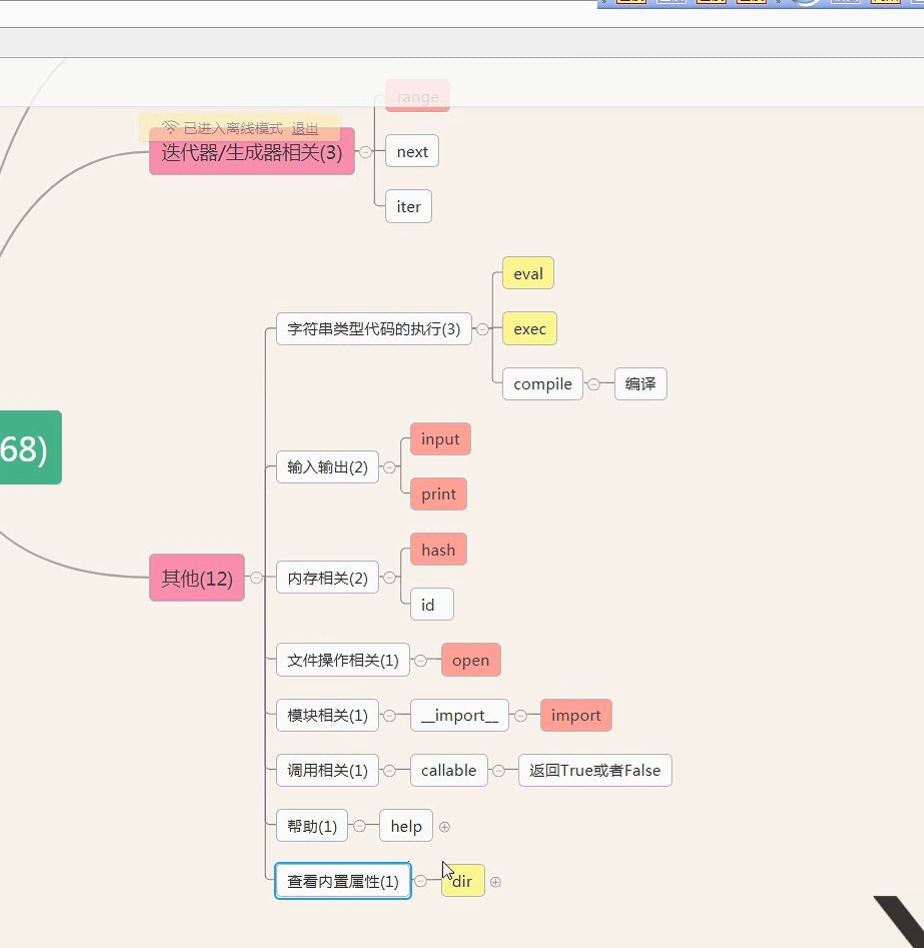



# print()
# input()
# len()
# type()
# open()
# tuple()
# list()
# int()
# bool()
# set()
# dir()
# id()
# str()
# print(locals()) #返回本地作用域中的所有名字
# print(globals()) #返回全局作用域中的所有名字
# global 变量
# nonlocal 变量
#迭代器.__next__()
# next(迭代器)
# 迭代器 = iter(可迭代的)
# 迭代器 = 可迭代的.__iter__()
# range(10)
# range(1,11)
# print('__next__' in dir(range(1,11,2)))
# dir 查看一个变量拥有的方法
# print(dir([]))
# print(dir(1))
# help
# help(str)
# 变量
# print(callable(print))
# a = 1
# print(callable(a))
# print(callable(globals))
# def func():pass
# print(callable(func))
import time
# t = __import__('time')
# print(t.time())
# 某个方法属于某个数据类型的变量,就用.调用
# 如果某个方法不依赖于任何数据类型,就直接调用 —— 内置函数 和 自定义函数
# f = open('1.复习.py')
# print(f.writable())
# print(f.readable())
#id
#hash - 对于相同可hash数据的hash值在一次程序的执行过程中总是不变的
# - 字典的寻址方式
# print(hash(12345))
# print(hash('hsgda不想你走,nklgkds'))
# print(hash(('1','aaa')))
# print(hash([]))
# ret = input('提示 : ')
# print(ret)
# print('我们的祖国是花园',end='') #指定输出的结束符
# print('我们的祖国是花园',end='')
# print(1,2,3,4,5,sep='|') #指定输出多个值之间的分隔符
# f = open('file','w')
# print('aaaa',file=f)
# f.close()
# import time
# for i in range(0,101,2):
# time.sleep(0.1)
# char_num = i//2
# per_str = '
%s%% : %s
' % (i, '*' * char_num)
# if i == 100 else '
%s%% : %s' % (i,'*'*char_num)
# print(per_str,end='', flush=True)
#progress Bar
# exec('print(123)')
# eval('print(123)')
# print(eval('1+2+3+4')) # 有返回值
# print(exec('1+2+3+4')) #没有返回值
# exec和eval都可以执行 字符串类型的代码
# eval有返回值 —— 有结果的简单计算
# exec没有返回值 —— 简单流程控制
# eval只能用在你明确知道你要执行的代码是什么
# code = '''for i in range(10):
# print(i*'*')
# '''
# exec(code)
# code1 = 'for i in range(0,10): print (i)'
# compile1 = compile(code1,'','exec')
# exec(compile1)
# code2 = '1 + 2 + 3 + 4'
# compile2 = compile(code2,'','eval')
# print(eval(compile2))
# code3 = 'name = input("please input your name:")'
# compile3 = compile(code3,'','single')
# exec(compile3) #执行时显示交互命令,提示输入
# print(name)
# name #执行后name变量有值
# "'pythoner'"
# 复数 —— complex
# 实数 : 有理数
# 无理数
# 虚数 :虚无缥缈的数
# 5 + 12j === 复合的数 === 复数
# 6 + 15j
# 浮点数(有限循环小数,无限循环小数) != 小数 :有限循环小数,无限循环小数,无限不循环小数
# 浮点数
#354.123 = 3.54123*10**2 = 35.4123 * 10
# f = 1.781326913750135970
# print(f)
# print(bin(10))
# print(oct(10))
# print(hex(10))
# print(abs(-5))
# print(abs(5))
# print(divmod(7,2)) # div出发 mod取余
# print(divmod(9,5)) # 除余
# print(round(3.14159,3))
# print(pow(2,3)) #pow幂运算 == 2**3
# print(pow(3,2))
# print(pow(2,3,3)) #幂运算之后再取余
# print(pow(3,2,1))
# ret = sum([1,2,3,4,5,6])
# print(ret)
# ret = sum([1,2,3,4,5,6,10],)
# print(ret)
# print(min([1,2,3,4]))
# print(min(1,2,3,4))
# print(min(1,2,3,-4))
# print(min(1,2,3,-4,key = abs))
print(max([1,2,3,4]))
print(max(1,2,3,4))
print(max(1,2,3,-4))
print(max(1,2,3,-4,key = abs))



